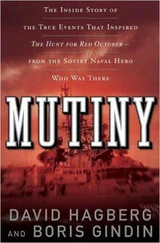With the extra sail area catching the wind, the Essex was moving well, probably at six to eight knots. The lookout spotted a ship ahead. Pollard ordered the helmsman to steer for her, and soon the Essex had caught up to what proved to be the whaleship Midas , five days out of New Bedford. Captain Pollard and the captain of the Midas exchanged shouted pleasantries, along with estimates of their longitude, and the Essex was soon pulling ahead, her entire crew undoubtedly enjoying the fact that their ship had proved to be what Nickerson called “the fastest sailor of the two.”
Later that day, the weather began to deteriorate. Clouds moved into the sky, and it grew suspiciously dark to the southwest. “The sea became very rough,” Nickerson remembered, “which caused the ship to roll and tumble heavily.” A storm seemed imminent, but the Essex “continued to carry a press of sail throughout the night and [the officers] had no cause to disturb the hands except for their respective watches.”
By the next morning they were in the Gulf Stream, and it was raining steadily. Nantucketers knew this eerily warm ocean current better than perhaps any other group of mariners. In the eighteenth century they had hunted sperm whales along its margins from Carolina to Bermuda. In 1786, Benjamin Franklin, whose mother, Abiah Folger, had been born on Nantucket, had used knowledge gleaned from his Nantucket “cousin,” whaling captain Timothy Folger, to create the first chart of the Gulf Stream.
Many considerations, both nautical and psychological, went into a decision to shorten sail. No captain wanted to be needlessly timid, yet taking unnecessary risks, especially at the beginning of a voyage that might last as long as three years, was unwise. At some point the conditions became so rough that Pollard elected to take in the fore and mizzen topgallant sails yet to leave flying the main topgallant and also the studding sails, usually the first sails taken down in worsening weather. Pollard may have wanted to see how the Essex performed when pushed to the limit. They sailed on, refusing to back down.
ACCORDING to Chase, they could see it coming: a large black cloud rushing toward them from the southwest. Now was surely the time to shorten sail. But once again they waited, deciding the cloud was an inconsequential gust. They would ride it out. As Chase would later admit, they “miscalculated altogether as to the strength and violence of it.”
In delaying, even for a second, shortening sail in the face of an approaching squall, Pollard was now flaunting his disregard of traditional seafaring wisdom. The officers of the British Navy had a maxim: “never to be overtaken unprepared by [a squall], as never to be surprised by an enemy.” It was said that the sharper and more defined the storm cloud, the worse the wind; thunder and lightning were also bad signs. When jagged streaks of lightning began to crackle out of the forbidding black sky and thunder boomed, Pollard finally began to issue orders. But it was too late.
In the face of an approaching squall, there were two options: either to point the ship into the oncoming wind, to relieve the pressure on the sails by letting them luff, or to turn almost 180 degrees in the opposite direction, away from the wind, and let the storm blow the ship with it. This relieved the pressure on the forward sails as they became partially becalmed in the shelter of the after ones. In the merchant service, in which ships were typically undermanned, some captains favored heading into the wind—what they called luffing through a squall—in part because heading up is the natural tendency of a sailing ship in a gust. Most captains, however, favored turning away from the wind—a strategy that required them to anticipate the arrival of the squall as the crew shortened the upper and aft sails. To attempt to bear away from the wind in the last few seconds before being struck by a squall was held to show “a poor appreciation of the squall, or a lack of watchfulness.”
This was precisely what happened to the Essex. As the squall approached, the helmsman was ordered to turn away from the direction of the wind and “run before it.” Unfortunately it took time for a ship the size of the Essex to respond to her rudder. When the gust slammed into the ship, she had just begun to turn and was sideways to the wind—the worst possible position.
For the green hands, the sound alone was terrifying: the shrieking of the wind across the rigging and then a frenzied flapping of sails and creaking of the stays and masts. The Essex began to lurch to leeward—slowly at first, the ponderous weight of the ship’s keel and ballast, not to mention the tons of stores stowed in her hold, refusing at first to yield, but then, as the wind increased, the ship inevitably succumbed to the merciless pressure of the wind.
When a ship is heeled over by forty-five degrees or more, her hull might be compared to a fat man on the short end of a lopsided seesaw. No matter how much he weighs, if the end of the seesaw on the other side of the pivot point is long enough, it becomes a lever that will eventually lift him up into the air as the distant tip of the seesaw settles softly to the ground. In the case of the Essex , the masts and their windpressed sails became levers prying the hull toward the point of no return, forcing it over until the tips of the yards were buried in the water. The Essex had been rolled almost ninety degrees onto her side—knocked over on her “beam-ends,” in the language of the sea.
Those on deck clung to the nearest fixture, fearful that they might fall down into the lee scuppers, now under knee-deep water. Those below deck did their best to shield themselves from objects falling down around them. If he hadn’t abandoned it already, the ship’s cook was doing his best to scramble out of the cookhouse, the heavy stove and cookware threatening to burst through its frail wooden sides. The two whaleboats on the Essex ’s port side had disappeared beneath the waves, pressed underwater by the massive weight of the capsized ship. According to Chase, “The whole ship’s crew were, for a short time thrown into the utmost consternation and confusion.”
Yet amid all the chaos there was, at least on deck, a sudden sense of calm. When a ship suffers a knockdown, her hull acts as a barrier against the wind and rain. Even though the ship had been slammed against the water, the men were temporarily sheltered from the howling forces of the wind. Pollard took the opportunity to pull the crew back together. “[T]he cool and undismayed countenance of the captain,” Nickerson remembered, “soon brought all to their sober senses.” The order was given to let go all the halyards and let the sheets run, but “the ship lay so far upon her side that nothing would run down as desired.”
If the squall continued to pin her on her beam-ends, the ship would begin to settle into the water as the sea rushed into the hull through her open hatchways. The longer she was over on her side, the greater the chances of the ballast and stores in her hold shifting to leeward, a disastrous turn of events from which she might never recover. Already the waves had wiped the cookhouse almost completely off the deck. As a last resort, it might be necessary to cut away the masts.
The rain poured down and the lightning flashed, and time slowed to a crawl as the men clung to the weather rail. But before the axes came into play, the ship twitched back to life. The men could feel it in their hands and feet and in the pits of their stomachs—an easing of the awful strain. They waited for another gust to slam the ship back down again. But no—the ballast continued to exert its gravitational pull, lifting the three masts until the yards came clear of the water. As the masts swung into the sky, seawater rushed across the deck and out the scuppers. The Essex shuddered to the vertical and was a ship again.
Читать дальше












